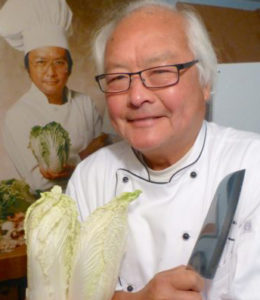Wok & Roll by Peter Kwong, (Frederic) Inter-County Leader
» Download this column as a Word document
A good friend asked me if I have any good lo mein recipes, as his family loves those crispy noodles with vegetables. “Oh, you mean chow mein,” I thought out loud,
not intending to embarrass him. After all, mein is mein — who cares as long as they are delicious?

Yes, “mein” means noodles in Chinese. There are many kinds of noodles but the most popular ones are made with wheat flour, or flour with egg. The other popular one is made with rice, which is called “mei fun.” Chow mein noodles are the crunchy ones, they are fried till the noodles are crisp and then the toppings are added to the top. Lo mein noodles are soft, which just come out from boiling water and then are mixed with shredded vegetables and sauces. Then there are noodles with soup. Shanghai noodles and won ton noodles fall into that category.
In Chinese, “chow” means stir-fry or fried. And “lo” simply means mix. The noodles used can be of any kind: flour noodles, egg noodles or Japanese/Korean-style udon noodles. Most noodles are manufactured in factories. They mix the ingredients, flour and water, sometimes with eggs added, in huge mixing bowls. Then the dough is flattened and sliced by a cutting machine. Some are packaged and sold as fresh noodles in the market while others are dried first and then packaged separately. Those would have a longer shelf life.
Most noodles are long strands that can be stretched over 10 feet or more, how they fold those long noodles in a small package is most interesting. For that reason, at most banquets honoring someone’s birthday, one of the main courses is “longevity noodles,” which may be served with soup or just stir-fried. The noodles served symbolize long life.
It is fascinating watching the server divide a big bowl of noodle soup amongst 10 or 12 guests. His left hand is equipped with a ladle, while the right hand holds a pair of long bamboo chopsticks. He fills the ladle first with as much of the noodles as he can and then skillfully cuts the strands with his chopsticks. He then goes around the table to serve everyone. It always amazes me that, no matter how many guests there are, there is always enough noodles for everyone.
There are many versions of chow mein. A lot of restaurants would put a bed of crispy fried noodles on the plate first and then add the stir-fried ingredients on top. I’ve seen a restaurant that actually used fried egg roll wrapper strips as crispy noodles and that works well.
So now the question remains … what do you prefer? I have come up with a simple recipe for each. So, try them and then you can decide.
Chicken chow mein (serves four):
Ingredients:
- Chicken, 1 lb. cut in strips and marinated with 1 tbs. cornstarch, sesame oil, sherry and soya sauce, “the four S’s.”
- Remember this: 1 tablespoon of each of the four S’s for 1 pound of meat.
- Vegetables: julienned zucchini, carrots, bean sprouts, broccoli and cabbage, 4 oz. of each.
- Noodles: 1 lb. dry flour noodle or egg noodle.
- Sauces: 1 tsp. black bean sauce; 2 tbs. oyster sauce; 1 tbs. sesame oil; 1/2 cup wine (add 1 glass for the chef).
First, cook the noodles in a big pot of boiling water, as you would for cooking spaghetti. Take out noodles when they are al dente, which translates to “to the tooth,” meaning soft but has a bite to it. Drain well, set aside and wait until the noodles are completely dry.
Second, in a heated wok, add 1 cup of oil. Fry the noodles, browning each side until it turns golden and crispy. Take them out and put on some paper towels to absorb the extra grease.
Third, leave wok with 1 tbs. of oil, add 1 tsp. black bean sauce and cook chicken strips until done. Remove chicken and add vegetable mix to wok. Cook for two to three minutes, add the cooked chicken, add 2 tbs. oyster sauce and top with sesame oil for extra aroma.
On a large platter, put fried crispy noodle at the bottom and pour the stir-fried chicken mix on top. That’s it. If you prefer more sauces, add a half cup of wine at the final stage. Rather than slicing and dicing vegetables, I just use a couple of packages of slaw mix to save time – they are already julienned carrots, broccoli stems with some red cabbages. If you are
like me and like your foods colorful with exotic flavors, add shitake mushrooms or, if you like it spicy, add a teaspoon of chili paste to your sauce. Again, you are the master, add whatever ingredients fancy you and your guests. Remember the golden rule: your food should look good, smell good and taste good.
Chicken lo mein
This is more simple. We can skip frying the noodles and just follow the rest of the procedures:
- Cut the chicken in strips and marinate with the four S’s.
- Boil and drain the noodles.
- Cook the chicken strips until done.
- Remove the chicken and cook the vegetables.
- Add chicken, noodles and mix well with the vegetables.
- Mix well, add a half cup of wine to make it more “saucy,” and don’t forget the glass of wine for the chef.
- Adjust the flavors with more oyster sauce.
- Add 1 tsp. of chili paste for a spicy kick.
Whatever mein you are going to try, it is going to be delicious. After all, it is fun and easy to make, and it is tasty for the whole family. Enjoy.



